②. 福建师范大学福建省湿润亚热带山地生态重点实验室-省部共建国家重点实验室培育基地, 福州 350007;
③. 中国科学院地质与地球物理研究所, 新生代地质与环境重点实验室, 北京 100029;
④. Department of Environment and Geography, Masquarie University, Sydney NSW 2109, Australia;
⑤. 太原师范学院汾河流域科学发展研究中心, 晋中 030619)
青藏高原作为地球的第三极,很大程度上改变了亚洲大气环流,对东亚乃至全球气候造成重要影响。青藏高原平均海拔超过4000m,其对对流层中上部的强烈加热效应,导致夏季高原面上出现低压,就像亚洲季风的泵,使得亚洲夏季风更加深入内陆,成为全球季风系统里面最强的季风子系统[1~3];另有研究指出,青藏高原面上夏季的加热效应在近高原面形成气旋型环流,根据四叶型加热原理,其东部将出现上升气流,大大加强亚洲季风的影响[2]。这些研究都强调了高原面在夏季剧烈的热效应对亚洲季风的强烈反馈作用。高原下垫面状况的改变,比如积雪面积的变化,就可能调制高原的热效应,从而影响亚洲夏季风[3]。青藏高原东南部是全球积雪分布的纬度最低的地区之一,其相当大面积的积雪覆盖可以改变高原面的热效应,从而对亚洲夏季风动态乃至全球气候起到重要影响;另外,亚洲第一和第三大河流,长江和雅鲁藏布江均流经青藏高原东南部,青藏高原东南部积雪面积的变化对这些河流的径流可能产生重要影响,从而影响长江和雅鲁藏布江中下游地区人们的生产和生活[4]。然而,青藏高原东南部的积雪面积记录非常缺乏,系统的基于卫星观测的记录只有几十年,大大限制了我们对积雪面积与亚洲季风关系及其对水文循环影响的理解,故亟待通过代用指标定量重建高分辨率的青藏高原东南部积雪面积的变化,并为过去气候变化的模拟提供边界条件资料。
积雪的增加可能使得生长季推迟,从而限制树木生长,反之亦然[5];另外,积雪还会影响土壤湿度,而土壤湿度是限制寒旱地区树木生长的重要影响因子[6~9],故我们推论树轮可能是重建积雪面积的理想材料。尽管我国树轮定量气候重建已经大量开展[6~19],然而基于树轮资料的对青藏高原积雪重建的探索还未见报道[5]。前人的研究发现,不同环境因子可能影响不同频率上树木的生长[20~24]。本文收集了青藏高原东南部25个树轮年表,分别分析了它们的年代际和年际尺度的变化,发现这些年表的年际波动之间存在较大的差别,可能是区域性差异的影响;而它们在年代际波动上存在很强的一致性,并且与青藏高原东南部的积雪覆盖有很好的相关关系,故定量重建了青藏高原东南部积雪覆盖的变化,并进一步探讨了区域积雪变化对树轮生长的影响及其对季风动态的反馈作用。
2 数据与方法我们收集了区域25条树轮宽度年表,这些树轮数据主要来自国际树轮数据库(ITRDB,www.ncdc.noaa.gov/data-access/paleoclimatology-data/datasets/tree-ring)和PAGES 2k[25]等项目( 表 1),这些树轮资料被用于重建区域干湿变化和温度等气候变化信息[26~28],这些对气候敏感的树轮也可能响应冰雪覆盖的变化。这些年表平均长度为444年,多数分布于缅甸与中国交接处的横断山地区,部分分布在川西和西藏南部( 图 1)。
| 表 1 树轮年表基本信息(灰色条带表示具有一致几十年尺度波动的9个树轮年表,其中代码表示该年表在国际树轮数据库(ITRDB)中的代码) Table 1 Meta data of the tree-ring chronologies and the grey shaded chronologies are the selected chronologies for the snow cover reconstruction. The codes are identical to the International Tree-ring Data Bank(ITRDB) |
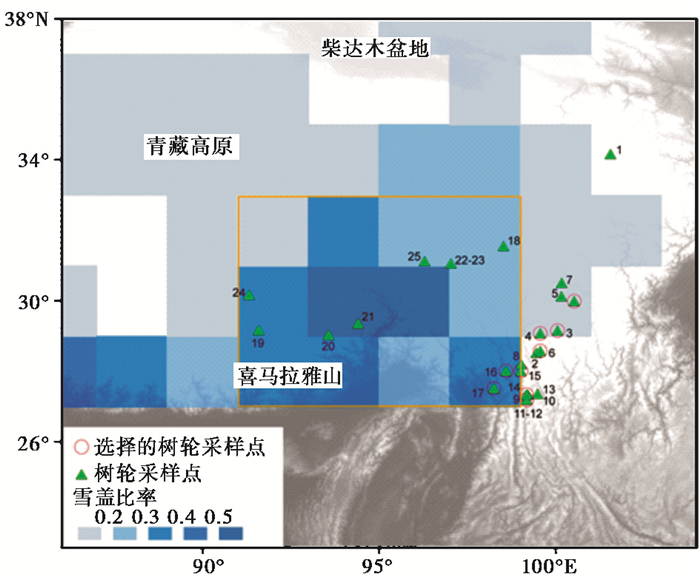
|
图 1 青藏高原东南部树轮样点、选择用于雪盖重建的树轮样点以及青藏高原东南部年平均雪盖分布基于1972~2009年的美国国家海洋大气局(NOAA)的资料;方框所示的范围为进行雪盖重建的区域;各个样点的序号所对应的年表见表 1所示,部分树轮样点相隔很近或经纬度相同(沿山体不同海拔分布),故样点位置具有重叠现象 Fig. 1 Locations of the tree-ring chronologies in southeastern Tibetan Plateau, the selected ones for snow cover reconstruction, and mean snow cover based on the data from 1972~2009 derived from the National Oceanic and Atmospheric Administration(NOAA), the square indicates the target region for snow cover reconstruction and the numbers of the sites are detailed in Table 1. Note that some sites overlap each other due to their very close locations |
这些年表分布存在积雪覆盖或积雪覆盖的边缘地区,积雪覆盖可能通过对区域气候和土壤水分的调控来影响这些树轮序列的生长。采集的树轮样本按照国际标准树轮气候学研究规范,将树轮样本首先固定在样槽中并晾干,然后打磨,进行交叉定年和测量[29, 30]。为了剔除可能由于树间竞争等干扰造成的树轮生长的差异,我们选用了序列67 %步长的样条函数来去除树轮宽度数据的百年和部分几十年尺度波动[31]。去除树木生长趋势后的年轮指数可能受到局地小生境干扰的影响,通过将树轮指数平均在一起建立树轮年表可以消除这部分影响。年表指数的建立通过加权平均进行,该方法对个别生长异常值赋予较低的权重[31]。由于年表的可靠性会随着样本量的降低而减弱,仿照前人关于包含多个树轮年表的树轮网络的可靠年表时段的选择方式,本文也选择样本量大于6的时段为年表的可靠年表时段[31~33]。
本文所使用的积雪覆盖数据来自美国国家海洋大气局的覆盖北半球(20°~90°N)周分辨率的积雪覆盖数据库(http://www.cpc.noaa.gov/data/snow/)。该数据时间跨度为1972年至2009年,空间分辨率为2°×2°,主要根据卫星数据和站点监测降雪量与积雪深度数据整理而成,每个格点记录下每周是否被积雪覆盖,格点积雪覆盖的年际波动就是格点年内被积雪覆盖的频率。本研究主要重建了青藏高原东南部(28°~32°N,92°~98°E)雪盖比较高的区域的雪盖变率。本研究还使用了东安吉利大学的CRU的自校正帕尔默干旱指数(Palmer Drought Severity Index, 简称PDSI,CRU scPDSI 3.21)来反应区域的干湿状况[34]。该全球数据集的计算基于1901~2012年的温度与降水月器测记录的资料,空间分辨率为0.5°×0.5°。该干旱指数数据集基于彭曼公式来计算潜在蒸发,较以往的数据集能更客观的反映干湿状况。尤其是该数据集考虑了积雪动态对土壤水分的影响,弥补了以往数据集在反映存在季节性积雪区域干湿状况的不足,适合与本文讨论积雪覆盖地区的研究。
考虑到该区域的器测记录多数始于20世纪50年代后期,故仅使用了1951年以来的干旱指数数据。本文还研究了树轮记录的雪盖与欧洲中期天气预报中心(European Centre for Medium-Range Weather Forecasts)的ERA-20C数据集的500hPa(约等于5000m高空的气压)的高度场数据的相关,该高度场的数据大致代表了研究区的近地面气压。同样,由于该区域的气象站主要在20世纪50年代建立,故本文仅选用50年代以后的气候资料。本研究还选用了butterworth滤波器来分别讨论年际和年代际尺度上树轮指数之间及其与气候资料之间的关系[35, 36]。
3 结果本文计算了雪盖和25个树轮年表的相关性,发现有9个树轮年表与春季到夏初(3~6月)的积雪覆盖表现出显著(p < 0.1)正相关( 表 1阴影)。这9个年表的平均值与春季到夏初积雪覆盖的相关系数为0.688。研究发现这些树轮年表彼此在年际波动上存在很大差异,不过在年代际波动上存在较大的一致性( 图 2)。这说明树轮年表和积雪之间的显著相关很大程度上是由于它们具有一致的年代际波动。年代际(f < 0.05)尺度上积雪覆盖和树轮年表的相关系数为0.825,由于进行了低通滤波,进行相关系数计算的自由度大大降低,我们根据Pyper和Peterman[37]的Chelton方法校正自由度后发现该相关系数仍然显著(p < 0.01),其有效自由度是4.54。故本文进一步地对比了这9个树轮年表在器测资料以前的年代际(f < 0.05和f < 0.02)波动,发现这些年表在器测资料以前的时段在年代际尺度上仍然具有很好的对应关系( 图 3和图 4)。
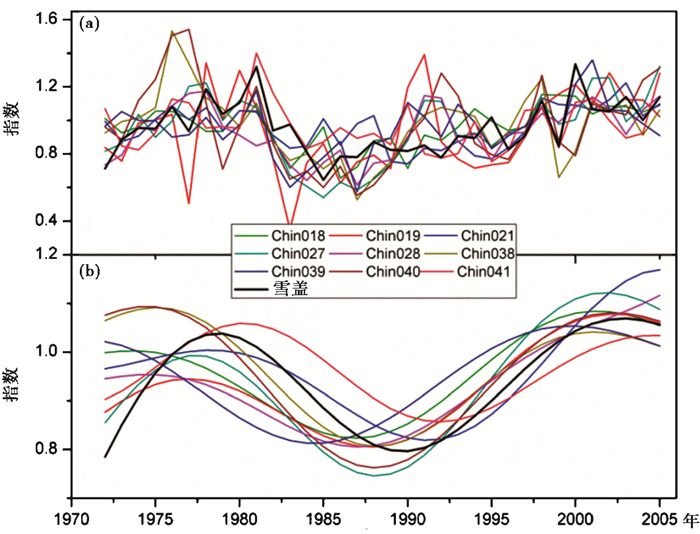
|
图 2 树轮年表与春季到初夏(3~6月)雪盖的对比(a)和年代际尺度(f < 0.05)上树轮年表与雪盖的对比(b)其中年表的代码如表 1所示,图 3和图 4同 Fig. 2 Comparisons between the tree-ring chronologies and the snow cover in spring and early summer(March to June)(a) and comparisons between these tree-ring chronologies and snow cover at the interdecadal timescale(f < 0.05)(b). The codes of these tree-ring chronologies were shown in Table 1, and the same with Fig.3andFig.4 |
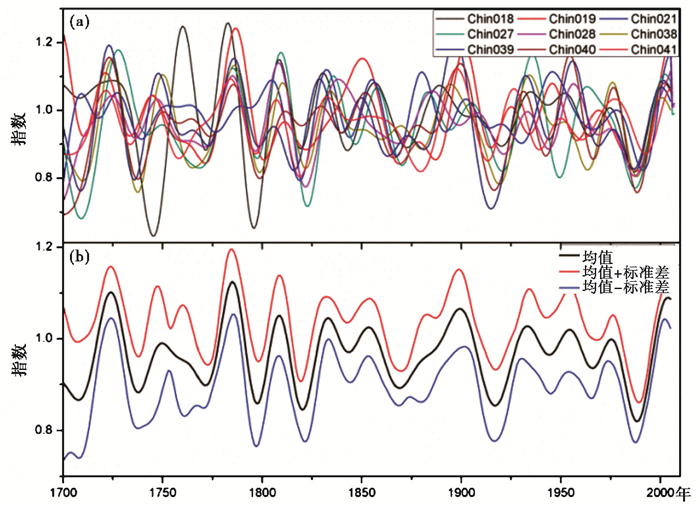
|
图 3 树轮年表的年代际(f < 0.05)波动的对比(a)和这些树轮年表年代际波动的均值与标准差(b) Fig. 3 Interdecadal( f < 0.05)variations of the tree-ring chronologies (a) and mean values and standard deviations of these tree-ring chronologies(b) |
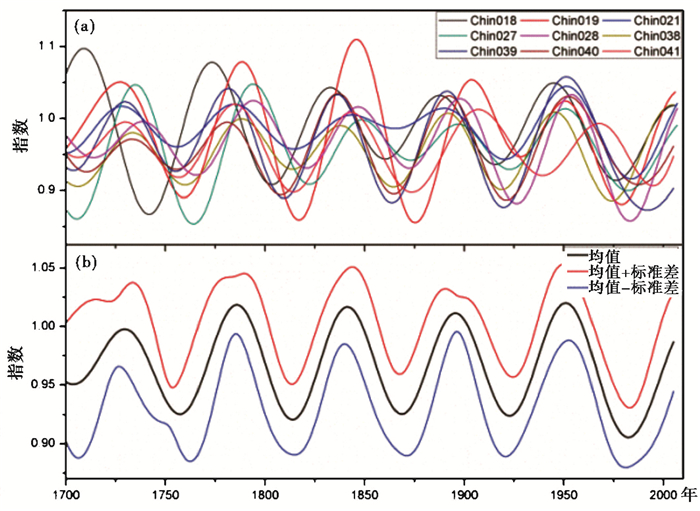
|
图 4 树轮年表的年代际(f < 0.02)波动的对比(a)和这些树轮年表的均值与标准差(b) Fig. 4 Interdecadal( f < 0.02)variations of the tree-ring chronologies (a) and mean values and standard deviations of these tree-ring chronologies(b) |
这说明这些树轮序列的年代际波动比较稳定的记录了过去300年以来的年代际积雪覆盖变化的信息。然而由于年际尺度上树轮和积雪覆盖波动的关系不显著,该重建并未包括年际波动。这些与积雪显著相关的树轮年表之间的标准差自1700年以来表现为波动上升的趋势,说明其年代际波动的一致性在不断加强。器测的积雪与PDSI以及树轮指数与PDSI之间均表现出了显著(p < 0.1)的相关( 图 5)。我们进一步对比树轮重建序列与历史资料重建的旱涝变化来评估的可靠性,因此本文收集基于历史资料的中国近500年旱涝分布图集[38]中分布于研究区内的站点,即黑河(31.48°N,92.06°E)、昌都(31.14°N,97.17°E)和拉萨(29.67°N,91.13°E),然而这些站点序列只有几十年。故本文进一步选择了研究区临近的站点,即康定(30.05°N,101.96°E)、西昌(27.90°N,102.27°E)、昭通(27.34°N,103.72°E)、大理(25.70°N,100.17°E)、腾冲(25.02°N,98.50°E)和昆明(25.02°N,102.68°E),并计算了这些站点旱涝指数的均值。如图 6所示,年代际尺度上(f < 0.02),树轮重建的积雪覆盖变化和基于历史文献记录重建的旱涝指数变化有较好的匹配关系,这进一步佐证了树轮积雪重建的可靠性以及该区域积雪变化和干湿变化的紧密关系。在1750年前,树轮和历史资料的不一致变化可能和该时期历史资料的记录缺乏有关,该时段仅位于研究区周边的昆明站有资料。树轮重建的积雪覆盖与500 hPa的气压之间存在正相关,说明积雪面积大的时候对应于区域近地面的高压( 图 7)。

|
图 5 春季到初夏(3~6月)器测雪盖(a)和树轮重建雪盖(b)与帕尔默干旱指数的相关方框显示的是进行雪盖重建的区域 Fig. 5 Correlations between the instrumental snow cover in spring and early summer(March to June)(a) and the reconstructed snow cover(b) and the Palmer drought severity index, respectively |
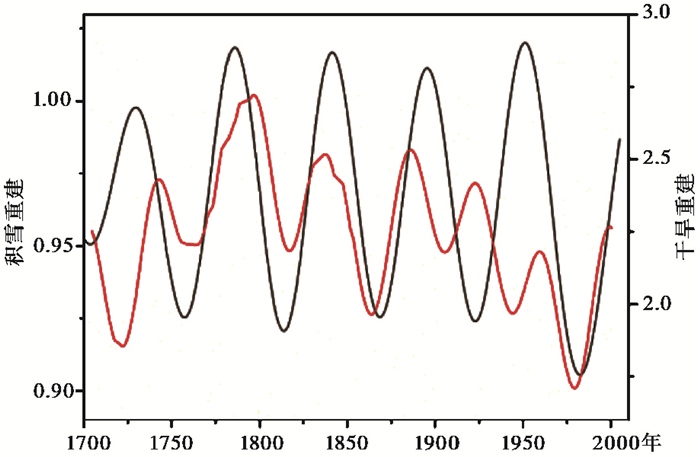
|
图 6 树轮年代际波动(f < 0.02)记录的积雪覆盖(黑线)与文献记录的年代际(f < 0.02)旱涝变化(红线)的对比本文对文献记录的旱涝等级做了反转(即5-旱涝等级),这样值越高表示越湿润,反之亦然,以便于和积雪覆盖曲线的对比 Fig. 6 Comparisons between the interdecadal (f < 0.02) variations of the snow cover reconstructions(black line)and the interdecadal (f < 0.02) drought reconstruction(red line)from historical documents. Note that the drought scale in the original documents based drought reconstructions were reversed with high values indicate wet conditions, and vice versa, to facilitate comparisons |
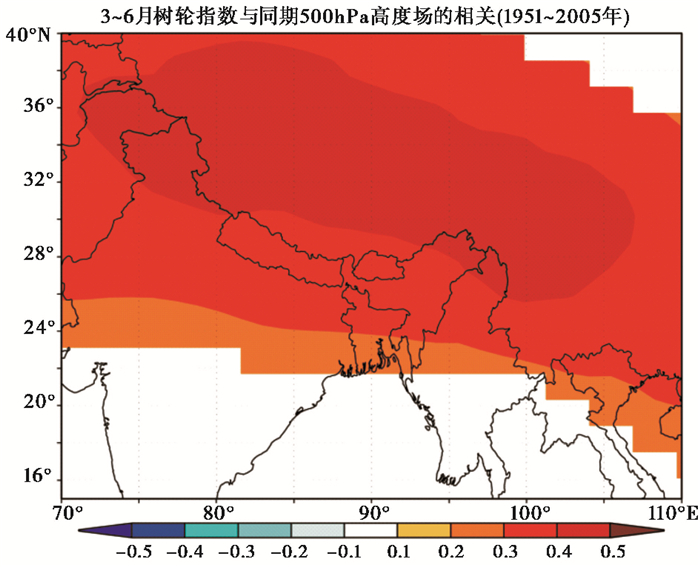
|
图 7 树轮指数与3~6月500 hPa高度场的相关(1951~2005年) Fig. 7 Correlations between tree-ring indices and the geopotential heights at 500 hPa from March to June during their common period from 1951 to 2005 |
不同于环北极地区积雪覆盖变化通过调控温度影响树木生长[5],本文并未发现积雪和温度的显著相关,积雪覆盖和树轮与帕尔默干旱指数的显著正相关说明积雪的减少主要是通过降低土壤湿度从而限制树木的生长。这主要是由于研究区较环北极地区更趋干旱[7, 28],尤其是在生长季早期,夏季风还未强盛到能够带来充足的降水,这个时期树轮宽度生长往往最为关键[39],此时丰富的积雪融水对树轮生长有重要的促进作用[40]。树轮年表的一致性逐步提高可能是由于升温导致的蒸散作用加强和干旱加剧,这样降雪对土壤湿度以及对树轮生长的促进作用就更显著,树轮生长与降雪的关系也更紧密了。降雪通过影响土壤湿度来影响树轮生长的另一个证据是这些对积雪表现出显著正相关的年表均表现出对干湿条件的高正响应,并曾经用于干湿变化的重建[7, 26, 28]。另外,雪盖还可以避免植物根系部分器官免受冻坏,有利于来年树木的生长[29]。
有意思的是年代际尺度上树轮生长和积雪覆盖有很好的对应关系( 图 2),说明雪盖对树木生长的影响在年代际尺度上更为显著,而在年际尺度上我们没有发现树轮生长和积雪覆盖的显著相关。前人也有研究发现不同环境因子可能对不同时间尺度上树轮的生长影响不同,如北美和我国西北地区的部分树轮可能在年代际尺度上表现出更好的一致性,并且与温度的关系比较好,记录了温度波动的信息;而这些树轮的年际波动更多记录的是区域干湿变化的特征,与干湿变化表现出更显著的相关关系[23, 24, 41]。这可能是因为这些区域的温度的波动在低频上更为显著,降水变化也往往表现出更强的年际波动特征。我们推断研究区积雪对树轮生长的影响集中在年代际波动上,可能也是由于积雪年代际波动表现地更为剧烈。由于该区域积雪面积较大,覆盖时间长,故这些积雪覆盖情况控制着区域的年代际的湿度条件。而年际尺度上积雪覆盖变化对区域气候的影响不大,积雪覆盖在年代际尺度的波动更为显著;另一方面,由于年际尺度上的大气温度和降水的影响可能超过了积雪对温度和湿度的改变,故积雪在年际尺度上的影响较小。也就是说,只有年代际尺度上积雪覆盖的变化对区域湿度格局的改变,超过年代际尺度上大气温度和降水改变的影响,从而对树木的年代际生长产生影响。据此,我们认为这些树轮年表的年代际波动( 图 3和图 4)能定量反映区域积雪覆盖的年代际波动。不同于以往研究指出树轮的低频波动主要响应温度[23, 24, 41],本文发现研究区树轮的低频波动主要响应低频干湿条件(PDSI)的变化( 图 5)。本文选择的这9条用于重建积雪变化的树轮序列主要位于横断山地区,区域相对于所选择的其他样点温度偏高,但是由于位于滇缅山脉的雨影区,区域春季降水相对偏少,故区域树轮序列表现出对春季干旱的响应[28],而积雪的增加对缓解区域季节性干旱有重要作用,可能是区域树轮表现出对积雪敏感的主要原因。而其他样点位于川西或藏南地区,温度偏低,降水相对充沛,春季干旱对树轮生长的限制性不显著[25],这可能是积雪分布对那些区域树轮生长不够敏感的原因。
区域积雪变化和亚洲夏季风的关系并不十分显著,主要和藏东南的干旱指数表现出显著相关,但与其他区域,如与季风核心区的显著相关( 图 5)。这可能是由于区域积雪覆盖和亚洲夏季风的反馈以及响应关系比较复杂,即其积雪覆盖不仅可以改变地面热力状况来反馈季风,使得季风减弱,出现反相关的关系;而降雪本身又很大程度依赖夏季风的强度,出现正相关关系,并且区域由于复杂的地形可能同时受到亚洲夏季风不同子系统的影响,如印度夏季风和西北太平洋夏季风[28]。因为大部分高原面上的降雪不受季风的影响,其积雪变化可能更显著反馈季风的动态,故我们建议未来的研究考虑重建整个青藏高原的积雪覆盖历史。不过需要提醒的是,青藏高原多数区域的积雪覆盖率没有研究区高,积雪覆盖可能对区域气候和区域树轮生长的影响不大,特定区域采样点选择的时候需要尽量考虑积雪覆盖率高的样点。尽管区域降雪和亚洲夏季风的关系比较复杂,我们仍然发现了一些积雪覆盖反馈亚洲夏季风的信号,比如本文发现区域积雪覆盖高的时期,由于近地面的高反照率和积雪融水的降温作用,夏季近地面的上升流减弱,近地面出现高气压异常。近地面的高压异常会减弱夏季青藏高原面的上升流以及印度夏季风的强度[42, 43]。另外,研究还发现青藏高原东北部积雪正异常对应着其南面的低海拔地区的湿度负异常,如藏南地区( 图 5a中蓝色部分)。绕喜马拉雅山的气流由于地形的影响,在研究区以南的低海拔地带存在一个动力作用的气旋,该气旋越强其降水越多[43]。两个区域湿度的反相关可能说明当夏季风将更多降水输送到高原东南部时候,其南侧低海拔地区的气旋异常减弱,故降水减少了。
5 总结本文收集了青藏高原东南部的25树轮年表来定量重建区域积雪覆盖的变化历史。研究选取了9个和区域积雪覆盖显著相关的树轮年表,发现它们在年代际尺度上的波动和积雪覆盖表现出更好的一致性,而在年际波动上则存在很大的差异。进一步研究发现年代际尺度上这些树轮年表的波动之间存在很高的一致性,说明这些树轮年表稳定的记录了过去300年来年代际尺度上的积雪覆盖的变化。研究发现区域积雪状况主要和干旱指数表现出高的正相关,说明区域积雪通过影响土壤干湿条件来影响树木的生长。树轮的年际生长可能受到区域温度和降水条件的影响,而年代际尺度上,积雪融水对干湿变化的影响超过了气温和降水的影响,故树轮在年代际尺度上与积雪覆盖表现出高的正相关。这是通过树轮资料进行积雪覆盖重建的首次尝试,该工作为研究历史时期高原积雪和亚洲季风动态研究提供了重要资料。
| 1 |
安芷生, 张培震, 王二七, 等. 中新世以来我国季风-干旱环境演化与青藏高原的生长.
第四纪研究,2006, 26 (5) : 678~693.
An Zhisheng, Zhang Peizhen, Wang Erchie, et al. Changes of the monsoon-arid environment in China and growth of the Tibetan Planteau since the Miocene. Quaternary Sciences,2006, 26 (5) : 678~693. (  0) 0)
|
| 2 |
吴国雄. 我国青藏高原气候动力学研究的近期进展.
第四纪研究,2004, 24 (1) : 1~9.
Wu Guoxiong. Recent progress in the study of the Qinghai-Xizang Plateau climate dynamics in China. Quaternary Sciences,2004, 24 (1) : 1~9. (  0) 0)
|
| 3 |
郑度. 青藏高原对中国西部自然环境地域分异的效应.
第四纪研究,2001, 21 (6) : 485~489.
Zheng Du. Qinghai-Xizang Plateau and its effects on regional differentiation of physical environments in West China. Quaternary Sciences,2001, 21 (6) : 485~489. (  0) 0)
|
| 4 |
游松财, KiyoshiTakahashi, YuzuruMatsuoka. 全球气候变化对中国未来地表径流的影响.
第四纪研究,2002, 22 (2) : 148~157.
You Songcai, Kiyoshi Takahashi, Yuzuru Matsuoka. Climate change impact on surface runoff in China. Quaternary Sciences,2002, 22 (2) : 148~157. (  0) 0)
|
| 5 |
Vaganov E A, Hughes M K, Kirdyanov A V, et al. Influence of snowfall and melt timing on tree growth in subarctic Eurasia.
Nature,1999, 400 : 149~151.
( 0) 0)
|
| 6 |
Chen F, Yuan Y, Wen W, et al. Tree-ring-based reconstruction of precipitation in the Changling Mountains, China, since AD1691.
International Journal of Biometeorology,2012, 56 (4) : 765~774.
( 0) 0)
|
| 7 |
Fan Z X, Bäuning A, Cao K F. Tree-ring based drought reconstruction in the central Hengduan Mountains region(China)since AD1655.
International Journal of Climatology,2008, 28 (14) : 1879~1887.
( 0) 0)
|
| 8 |
Li J, Cook E R, Chen F, et al. Summer monsoon moisture variability over China and Mongolia during the past four centuries.
Geophysical Research Letters,2009, 36 (22) : L22705.
doi: 10.1029/2009GL041162 ( 0) 0)
|
| 9 |
Gou Xiaohua, Deng Yang, Chen Fahu, et al. Tree ring based streamflow reconstruction for the upper Yellow River over the past1234 years.
Chinese Science Bulletin,2010, 55 (36) : 4179~4186.
( 0) 0)
|
| 10 |
Liang E, Shao X, Qin N. Tree-ring based summer temperature reconstruction for the source region of the Yangtze River on the Tibetan Plateau.
Global and Planetary Change,2008, 61 (3) : 313~320.
( 0) 0)
|
| 11 |
Liu Yu, An Zhisheng, Ma Haizhou, et al. Precipitation variation in the northeastern Tibetan Plateau recorded by the tree rings since850 AD and its relevance to the Northern Hemisphere temperature.
Science in China(Series D),2006, 49 (4) : 408~420.
( 0) 0)
|
| 12 |
Shao X, Xu Y, Yin Z Y, et al. Climatic implications of a3585-year tree-ring width chronology from the northeastern Qinghai-Tibetan Plateau.
Quaternary Science Reviews,2010, 29 (17) : 2111~2122.
( 0) 0)
|
| 13 |
Yang B, Qin C, Wang J, et al. A3, 500-year tree-ring record of annual precipitation on the northeastern Tibetan Plateau.
Proceedings of the National Academy of Sciences of the United States of America,2014, 111 (8) : 2903~2908.
( 0) 0)
|
| 14 |
Zhang Q B, Cheng G D, Yao T D, et al. A2, 326-year tree-ring record of climate variability on the northeastern Qinghai-Tibetan Plateau.
Geophysical Research Letters,2003, 30 (14) : 1739~1742.
( 0) 0)
|
| 15 |
Liu X, An W, Treydte K, et al. Tree-ring δ18O in Southwestern China linked to variations in regional cloud cover and tropical sea surface temperature.
Chemical Geology,2012, 291 (1) : 104~115.
( 0) 0)
|
| 16 |
Yuan Yujiang, Jin Liya, Shao Xuemei, et al. Variations of the spring precipitation day numbers reconstructed from tree rings in the Vrümqi River drainage, Tianshan Mts. over the last370 years.
Chinese Science Bulletin,2003, 48 (14) : 1507~1510.
( 0) 0)
|
| 17 |
刘禹, 蔡秋芳, 宋慧明. 关于青藏高原2485年温度的季节和空间代表性问题.
第四纪研究,2013, 33 (1) : 108~114.
Liu Yu, Cai Qiufang, Song Huiming. Seasonal and spatial representativeness of the tree-ring based2485-year annual mean temperature reconstruction in the northeastern Tibetan Plateau. Quaternary Sciences,2013, 33 (1) : 108~114. (  0) 0)
|
| 18 |
杨保. 树轮记录的小冰期以来青藏高原气候变化的时空特征.
第四纪研究,2012, 32 (1) : 81~94.
Yang Bao. Spatial and temporal patterns of climate variations over the Tibetan Plateau during the period1300-2010. Quaternary Sciences,2012, 32 (1) : 81~94. (  0) 0)
|
| 19 |
刘晶晶, 杨保. 西藏浪卡子地区树轮宽度特征值年表的建立.
第四纪研究,2014, 34 (6) : 1280~1287.
Liu Jingjing, Yang Bao. Development of a tree-ring-width chronology using the Eigen analysis method in Langkazi regions of Tibet. Quaternary Sciences,2014, 34 (6) : 1280~1287. (  0) 0)
|
| 20 |
程雪寒, 吕利新. 藏东南树木年轮记载的公元1560年以来的极端干旱事件.
第四纪研究,2015, 35 (5) : 1093~1101.
Cheng Xuehan, Lü Lixin. Extreme drought events since1560 A.D. recorded by tree rings on the southeast Qinghai-Tibeatan Plateau. Quaternary Sciences,2015, 35 (5) : 1093~1101. (  0) 0)
|
| 21 |
史锋, 杨保, 赵森, 等. 全球过去千年典型暖期温度空间格局重建.
第四纪研究,2014, 34 (6) : 1125~1135.
Shi Feng, Yang Bao, Zhao Sen, et al. Spatial pattern reconstruction of typical centennial warm periods of global temperature over the past millennium. Quaternary Sciences,2014, 34 (6) : 1125~1135. (  0) 0)
|
| 22 |
肖丁木, 秦宁生, 黄小梅. 树轮记录的川西高原北部过去325年7-8月平均气温变化.
第四纪研究,2015, 35 (5) : 1134~1144.
Xiao Dingmu, Qin Ningsheng, Huang Xiaomei. A325-year reconstruction of July-August mean temperature in the north of west Sichuan derived from tree-ring. Quaternary Sciences,2015, 35 (5) : 1134~1144. (  0) 0)
|
| 23 |
Fang K, Gou X, Levia D F, et al. Variation of radial growth patterns in trees along three altitudinal transects in north Central China.
IAWA Journal,2009, 30 (4) : 443~457.
( 0) 0)
|
| 24 |
Fang K, Gou X, Chen F, et al. Response of regional tree-line forests to climate change:Evidence from the northeastern Tibetan Plateau.
Trees-Structure and Function,2009, 2 (6) : 1321~1329.
( 0) 0)
|
| 25 |
PAGES2k Consortium. Continental-scale temperature variability during the past two millennia.
Nature Geoscience,2013, 6 (5) : 339~346.
( 0) 0)
|
| 26 |
Cook E, Anchukaitis K J, Buckley B M, et al. Asian monsoon failure and megadrought during the last millennium.
Science,2010, 328 (5977) : 486~489.
( 0) 0)
|
| 27 |
Cook E R, Krusic P J, Anchukaitis K J, et al. Tree-ring reconstructed summer temperature anomalies for temperate East Asia since800 CE.
Climate Dynamics,2013, 41 (11-12) : 1~16.
( 0) 0)
|
| 28 |
Fang K, Gou X, Chen F, et al. Reconstructed droughts for the southeastern Tibetan Plateau over the past568 years and its linkages to the Pacific and Atlantic Ocean climate variability.
Climate Dynamics,2010, 35 (4) : 577~585.
( 0) 0)
|
| 29 |
Fritts H C.
Tree Rings and Climate. New York: Academic Press, 1976 : 1 ~584.
( 0) 0)
|
| 30 |
Stokes M A, Smiley T L.
An Introduction to Tree-ring Dating. Chicago: University of Chicago Press, 1968 : 1 ~73.
( 0) 0)
|
| 31 |
Cook E R. A Time Series Analysis Approach to Tree Ring Standardization(Dendrochronology, Forestry, Dendroclimatology, Autoregrcesive Process).
Tuscon:The Ph.D Dissertation of University of Arizona,1985 : 1~171.
( 0) 0)
|
| 32 |
Fang K, Gou X, Chen F, et al. Large-scale precipitation variability over Northwest China inferred from tree rings.
Journal of Climate,2011, 24 (13) : 3457~3468.
( 0) 0)
|
| 33 |
Cook E, Meko D M, Stahle D W, et al. Drought reconstructions for the continental United States.
Journal of Climate,1999, 12 (4) : 1145~1162.
( 0) 0)
|
| 34 |
Schrier G, Barichivich J, Briffa K, et al. A scPDSI-based global data set of dry and wet spells for1901-2009.
Journal of Geophysical Research:Atmospheres,2013, 118 (10) : 4025~4048.
( 0) 0)
|
| 35 |
Ghil M, Allen M, Dettinger M, et al. Advanced spectral methods for climatic time series.
Reviews of Geophysics,2002, 40 (1) : 3~1.
( 0) 0)
|
| 36 |
Mann M E, Zhang Z, Rutherford S, et al. Global signatures and dynamical origins of the Little Ice Age and Medieval climate anomaly.
Science,2009, 326 (5957) : 1256~1260.
( 0) 0)
|
| 37 |
Pyper B J, Peterman R M. Comparison of methods to account for autocorrelation in correlation analyses of fish data.
Canadian Journal of Fisheries and Aquatic Sciences,1998, 55 (9) : 2127~2140.
( 0) 0)
|
| 38 |
张德二, 李小泉, 梁有叶. 《中国近五百年旱涝分布图集》的再续补(1993-2000年).
应用气象学报,2003, 14 (3) : 379~388.
Zhang De'er, Li Xiaoquan, Liang Youye. Supplement of yearly charts of dryness/wetness in China for the last500-year period, 1993-2000. Journal of Applied Meteorology,2003, 14 (3) : 379~388. (  0) 0)
|
| 39 |
Gou X, Zhou F, Zhang Y, et al. Forward modeling analysis of regional scale tree-ring patterns around the northeastern Tibetan Plateau, Northwest China.
Biogeosciences,2013, 10 (6) : 9969~9988.
( 0) 0)
|
| 40 |
Fang K, Frank D, Zhao Y, et al. Moisture stress of a hydrological year on tree growth in the Tibetan Plateau and surroundings.
Environmental Research Letters,2015, 10 (3) : 034010.
doi: 10.1088/1748-9326/10/3/034010 ( 0) 0)
|
| 41 |
Hughes M K, Funkhouser G. Frequency-dependent climate signal in upper and lower forest border tree rings in the mountains of the Great Basin.
Climate Change,2003, 59 (1) : 233~244.
( 0) 0)
|
| 42 |
Kang S, Xu Y, You Q, et al. Review of climate and cryospheric change in the Tibetan Plateau.
Environmental Research Letters,2010, 5 (015101) .
doi: 10.1088/1748-9326/5/1/015101 ( 0) 0)
|
| 43 |
Tang H, Micheels A, Eronen J, et al. Regional climate model experiments to investigate the Asian monsoon in the Late Miocene.
Climate of the Past,2011, 7 (3) : 847~868.
( 0) 0)
|
②. Key Laboratory for Subtropical Mountain Ecology(Ministry of Science and Technology and Fujian Province Funded), Fujian Normal University, Fuzhou 350007;
③. Key Laboratory of Cenozoic Geology and Environment, Institute of Geology and Geophysics, Chinese Academy of Sciences, Beijing 100029;
④. Department of Environment and Geography, Macquarie University, Sydney NSW 2109, Australia;
⑤. Research Center for Scientific Development in Fenhe River Valley, Taiyuan Normal University, Jinzhong 030619)
Abstract
The southeastern Tibetan Plateau has one of largest subtropical snow cover due to its low temperature and high precipitation. Changes of the snow cover in the southeastern Tibetan Plateau are not only influenced by the Asian summer monsoon but can also strongly feedback the dynamics of the monsoon by changing the thermal conditions of the plateau. The brevity of the instrumental snow cover data of a few decades has limited our ability to detect the interactions between snow cover and Asian summer monsoon, particularly for the interdecadal scale. This is a first tree-ring based snow cover reconstruction for the Tibetan Plateau. We collected 25 tree-ring chronologies in the southeastern Tibetan Plateau (28°~32°N, 92°~98°E) and found 9 of them are significantly correlated with the snow cover changes. These 9 chronologies concentrate in northern Yunnan Province in the rain shadow region of the mountain ranges between Myanmar and China. Tree rings in these relatively dry regions are generally sensitive to moisture. Further, we found that the good matches between snow cover and tree-ring variations are only for the interdecadal changes but not conspicuous for the interannual changes. The interdecadal variations of these tree-ring chronologies agree with each other well through their common period of the past 300 years. This suggests that these chronologies are likely controlled by one environmental factor of the snow cover, and the relationships between tree growth and snow cover at the interdecadal time scale are stable over time. The snow cover modulates the growth of tree rings via modulating the soil moisture as indicated by the high correlations between tree growth and the snow cover and the drought index. The influences of snow cover on tree growth outcompete the other factors at the interdecadal scale, while at the interannual scale, tree growth may be dominated by the local climate change as indicated by varying interannual variations among these 9 tree-ring chronologies with coherent interdecadal variations. Our study adds in evidences that different environmental factors may modulate tree growth at different time scales. This study reconstructed the snow cover changes in the southeastern Tibetan Plateau over the past 300 years using tree rings and explored its linkages with the Asian summer monsoon. The tree-ring based snow cover reconstructions agree well with the drought reconstructions from the local historical documets. 2016, Vol.36
2016, Vol.36
